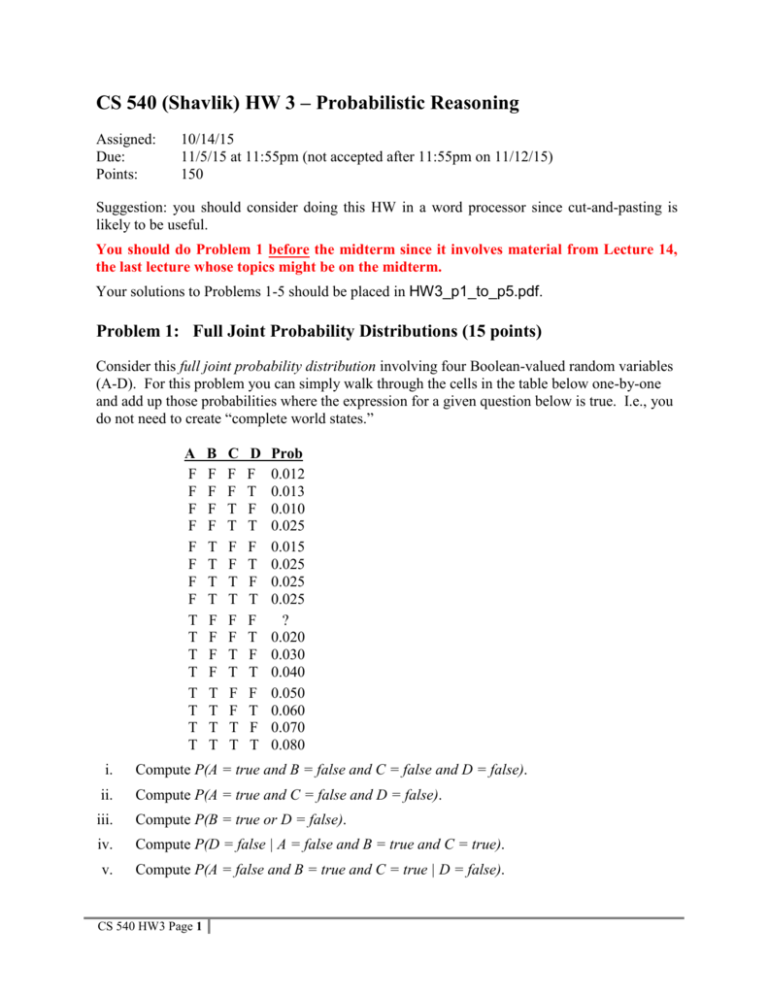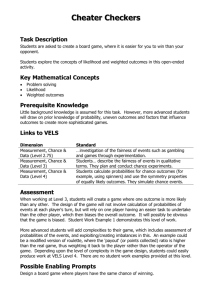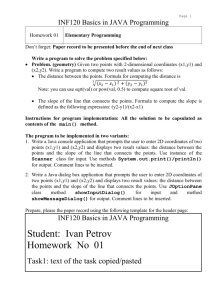HW3
advertisement

CS 540 (Shavlik) HW 3 – Probabilistic Reasoning
Assigned:
Due:
Points:
10/14/15
11/5/15 at 11:55pm (not accepted after 11:55pm on 11/12/15)
150
Suggestion: you should consider doing this HW in a word processor since cut-and-pasting is
likely to be useful.
You should do Problem 1 before the midterm since it involves material from Lecture 14,
the last lecture whose topics might be on the midterm.
Your solutions to Problems 1-5 should be placed in HW3_p1_to_p5.pdf.
Problem 1: Full Joint Probability Distributions (15 points)
Consider this full joint probability distribution involving four Boolean-valued random variables
(A-D). For this problem you can simply walk through the cells in the table below one-by-one
and add up those probabilities where the expression for a given question below is true. I.e., you
do not need to create “complete world states.”
A
F
F
F
F
F
F
F
F
T
T
T
T
T
T
T
T
B
F
F
F
F
T
T
T
T
F
F
F
F
T
T
T
T
C
F
F
T
T
F
F
T
T
F
F
T
T
F
F
T
T
D
F
T
F
T
F
T
F
T
F
T
F
T
F
T
F
T
Prob
0.012
0.013
0.010
0.025
0.015
0.025
0.025
0.025
?
0.020
0.030
0.040
0.050
0.060
0.070
0.080
i.
Compute P(A = true and B = false and C = false and D = false).
ii.
Compute P(A = true and C = false and D = false).
iii.
Compute P(B = true or D = false).
iv.
Compute P(D = false | A = false and B = true and C = true).
v.
Compute P(A = false and B = true and C = true | D = false).
CS 540 HW3 Page 1
Problem 2: Bayesian Networks (20 points)
Consider the following Bayesian Network, where variables A-D are all Boolean-valued:
P(A=true) = 0.9
A
B
A
false
false
true
true
B
false
true
false
true
P(C =true | A, B)
0.4
0.5
0.6
0.7
A
false
true
P(B =true | A)
0.8
0.1
C
D
B
false
false
true
true
C
false
true
false
true
P(D =true | B,C)
0.2
0.1
0.9
0.3
Show your work for the following calculations.
i.
Compute P(A = true and B = true and C = true and D = true).
ii.
Compute P(A = false and C = false and D = false).
iii.
Compute P(C = true | A=true and B=true and D=true).
iv.
Compute P(D= false | B = true and C = true). // Use the Markov Blanket property here.
v.
Compute P(D= false | A=true and B = true and C = true).
// Do this one without employing the Markov Blanket property (i.e., to algebraically or
// numerically confirm that knowing A=true doesn’t change the result from iv).
vi.
Compute P((A = false and C = false) or (B = true and D = true)).
CS 540 HW3 Page 2
Problem 3: BNs and Full Joint Probability Tables (5 points)
Use the Bayes Net from Problem 2 to fill in the top quarter of the full joint probability table
below (feel free to fill it all in, but to reduce the tedium we are only requiring you to fill in the
top quarter). Show your work.
A
F
F
F
F
F
F
F
F
T
T
T
T
T
T
T
T
CS 540 HW3 Page 3
B
F
F
F
F
T
T
T
T
F
F
F
F
T
T
T
T
C
F
F
T
T
F
F
T
T
F
F
T
T
F
F
T
T
D Prob
F
?
T
?
F
?
T
?
F
?
T
?
F
?
T
?
F
?
T
?
F
?
T
?
F
?
T
?
F
?
T
?
Problem 4: Bayes' Rule (20 points)
Define the following two variables about people:
shot
flu
= got flu shot last year
= caught flu this year
Assume we know from past experience that:
P(shot)
P(flu)
P(flu | shot)
=
=
=
0.6
0.4
0.2
i.
Given someone did not get a shot, what is the probability he or she does gets the flu?
ii.
Given you find out someone got the flu, what's the probability he or she
got a shot?
Be sure to show and explain your calculations for both parts (i) and (ii). Start by writing out the
above questions as conditional probabilities.
In the general population, 10 in a 100,000 people have the dreaded DislikeHomework disease.
Fortunately, there is a test (test4it) for this disease that is 97.5% accurate. That is, if one has the
disease, 975 times out of 1000 test4it will turn out positive; if one does not have the disease,
25 times out of 1000 the test will turn out positive.
iii.
You take test4it and the results come back true. Use Bayesian reasoning to calculate
the probability that you actually have DislikeHomework. That is, compute:
P(DislikeHomework = true | test4it = true)
Show your work; you may use DH for DislikeHomework and T4 for test4it
if you wish.
CS 540 HW3 Page 4
Problem 5: Naïve Bayes and ‘Bag-of-Words’ Text Processing (15 points)
Sally has divided her books into two groups, those she likes and those she doesn't. For simplicity,
assume no book contains a given word more than once.
The 8 books that Sally likes contain (only) the following words:
animal (7 times), vegetable (1 time), see (6 times), eat (2 times)
The 12 books that Sally dislikes contain (only) the following words:
animal (11 times), mineral (3 times), vegetable (8 times), see (9 times), eat (5 times)
Using Bayes Rule and the Naive Bayes assumption, determine whether it is more probable that
Sally likes the following book (call it book23) than that she dislikes it.
see animal eat vegetable
// These four words are the entire contents of book23.
That is, compute the ratio:
Prob(Sally likes book23 | ‘see’ in book ˄ ‘animal’ in book ˄ ‘eat’ in book ˄ ‘vegetable’ in book)
Prob(Sally dislikes book23 | ‘see’ in book ˄ ‘animal’ in book ˄ ‘eat’ in book ˄ ‘vegetable’ in book)
Be sure to show and explain your work. Ensure that none of your probabilities are zero by
starting all your counters at 1 instead of 0 (the counts above result from starting at 0, i.e., imagine
that there is one more book (book21) that Sally likes that contains each of the five unique words
above exactly once and also one more book (book22) she dislikes that also contains each of the
above five words exactly once).
Technical note: in the evidence (ie, the 'given') part of the above conditional probabilities we are
ignoring the words not present in the book (i.e., mineral). This is different from our usual 'fixedlength feature vector' view of data, where instances of randomVar=false impact the calculation.
Since the average vocabulary is around 50,000 words, when dealing with text as our data we
want to focus on the words present rather than having the absence of tens of thousands of words
impact the calculation.
You can visualize the random process as follows. There is one bag of all the books that Sally
would like (this bag contains many more than the books mentioned above; these 'liked' books are
just a sample drawn from this bag). There is a second bag, which contains all the books that
Sally would dislike. If we draw a book from the 'likes' bag, what is the probability this book
contains the word see? What would this probability be if we draw a book from the 'dislikes' bag?
Since we are assuming conditional independence of the words given the type of book (liked vs.
disliked), we repeat this process for animal, then repeat for eat, and finally repeat for vegetable.
We also need to remember to include the answer to: if we combined these two bags of books and
then (uniformly) randomly drew a book from the combination, what is the probability we drew a
book Sally liked?
CS 540 HW3 Page 5
Problem 6: Creating Probabilistic Reasoners that Play Nannon (75 points)
This problem involves writing Java code that implements three probabilistic reasoners to play the
two-person board game called Nannon (http://nannon.com), which is a simplified version of the
well-known game Backgammon (http://en.wikipedia.org/wiki/Backgammon). Instructions for Nannon
are available at http://nannon.com/rules.html.
Here is how we will formulate the task. At each turn, whenever there is more than one legal
move, your chooseMove method is given access to:
1) The current board configuration.
2) A list of legal moves; each move's effect is also provided, and you are able to
determine the next board configuration from each move. (Explanations of which
effects are computed for you appear in the chooseMove method of the provided
RandomNannonPlayer and in the ManageMoveEffects.java file).
Your chooseMove method needs to return one of the legal moves. It should do this by using
Bayes’ Rule to estimate the odds each move will lead to a winning game, returning the one with
the highest odds. That is, it should compute for each possible move:
Prob(will win game | current board, move, next board, and move’s effect)
______________________________________________________________
Prob(will lose game | current board, move, next board, and move’s effect)
Your solution need not use ALL of these given’s to estimate these probabilities, and you can
choose to define whichever random variables you wish from the provided information. The
specific design is up to you and we expect each student’s solution to be unique.
You need to create three solutions. In one, you will create a full joint probability table. In the
other two you will create two (Bayesian Networks (BNs); neither can be a BN equivalent to your
full joint probability table. One BN should be Naive Bayes (NB) and the other needs to somehow
go beyond the NB conditional-independence assumption (see Lecture 17). It is up to you to
decide the specific random variables used and, for the non-naive Bayesian Network, which
conditional independence assumptions you wish to make. The random variables in your three
solutions need not be the same.
You need to place your three solutions in these files, where YourMoodleLoginName is your
actual Moodle (i.e., your UWisc) login:
FullJointProbTablePlayer_YourMoodleLoginName.java
NaiveBayesNetPlayer_YourMoodleLoginName.java
BayesNetPlayer_YourMoodleLoginName.java
Copy all the Java files in http://pages.cs.wisc.edu/~shavlik/cs540/HWs/HW3/ to your working space.
The provided PlayNannon.java, NannonPlayer.java, and RandomNannonPlayer.java files
contain substantial details on what you need to do. You should start by reading the comments in
them; I suggest you read the files in the order they appear in the previous sentence.
So how do you get the necessary information to compute these probabilities? After each game,
your players’ updateStatistics method is given information about the sequence of board
CS 540 HW3 Page 6
configurations encountered and the moves chosen by your player in that game, as well as
whether or not your player won that game. You should not try to figure out which moves where
good or bad in any one specific games; instead, if a game was won, all moves in it should be
considered good (i.e., led to a win) and if a game is lost all moves should be considered bad (led
to a loss). Obviously some moves in losing games were good and vice versa, but because we are
using statistics, we are robust to this ‘noise.’
Your three players need to implement the reportLearnedModel method, which reports the value
of the random variable (or values of the combination of random variables) where the following
ratio is largest (i.e., most indicative of a win) and the smallest (i.e., most indicative of a loss):
prob( randomVariable(s) | win) / prob(randomVariable(s) | loss)
For your full-joint-prob table, randomVariables should be a setting of all the random variables
other than the ‘win’ variable (i.e., loss = ¬win). For your NB player, randomVariable(s) should
be one variable other than win. For your Bayes Net approach, randomVariable(s) should be
one of the non-NB entries in the product of probabilities you compute. (Recall that if we want to
allow some dependencies among our random variables, the product in a non-naive Bayes Net
calculation will include something like p(A | B win) x p(B | win), which is equivalent to
p(A B | win), as explained in class.)
The reportLearnedModel method is automatically called (by code we have written) after a run of
k games completes when Nannon.reportLearnedModels is set to true.
It is fine to print more about what was learned, but the above requested information should be
easy to find in your printout.
What needs to be turned in, in addition to the three Java files listed above (be sure to comment
your code)? A report (in HW3_p6.pdf) containing:
1. A description of your design for your FullJointProbTablePlayer; should be 1-2 pages.
Include an illustrative picture (the picture can be hand drawn). Don’t draw the complete
full-joint table, but provide a visual of its contents.
2. A description of your design for your NaiveBayesNetPlayer; should be 1-2 pages. An
illustrative picture of your Bayes Net is required (the picture can be hand drawn).
3. A description of your design for your BayesNetPlayer; should be 1-2 pages. An
illustrative picture of your Bayes Net is required (the picture can be hand drawn). Focus
your discussion on the differences from your NB player.
4. A 1-2 page report presenting and discussing how your three players performed against
each other, as well as against the provided ‘hand coded’ and ‘random moves’ players.
Create a table where the columns are (change “Your” to “My” in your report):
YourFullJoint
YourNB
YourBN
YourNB
YourBN
And the rows are
YourFullJoint
CS 540 HW3 Page 7
HandCoded Random
Feel the ‘upper triangle’ portion of this table with the results (the percentage of the time
the column’s label beat the row’s label) on the 6 cells x 3 pieces per player board using
1M games after 1K ‘burn-in’games.
Please type your report.
Here some statistics from my solution on the 6 cells x 3 pieces per player board. Note that
results can vary depending on the ‘seed’ for the random-number generator. Also note that
several students’ solutions beat my solutions in previous cs540 classes.
33% random-moves vs 67% my Full-Joint Player
47% hand-coded
vs 53% my Full-Joint Player
33% random-moves vs 67% my Bayes Net
46% hand-coded
vs 54% my Bayes Net
39% random-moves vs 61% my Naive Bayes
52% hand-coded
vs 48% my Naive Bayes
(so don't worry if your Bayes Net cannot beat the hand-coded player)
Note that we will test your NaiveBayesNetPlayer and your BayesNetPlayer under various
conditions. The PlayNannon.java file provides details. Also note that you should not modify
any of the provided Java files since when we test your solution we will be using the original
versions of these files.
A class-wide tournament will be conducted soon after this homework is due, using your nonnaive BN player. It will be for fun and a learning experience (e.g., what did the winner(s) do that
worked so well?); performance in this tournament will not be part of your grade on this
homework. If your code is too slow, uses too much RAM, or crashes, it won’t be able to
participate in the class-wide tournament. Hopefully the tournament-running code can handle
solutions that use no more than 8GB RAM and play one million games in less than a minute
(these ‘specs’ subject to change; my goal is to include all students’ solution, but the first time I
did this in cs540, dealing with 3-4 ‘outlier’ solutions took up about half my time).
Feel free to create additional players based on genetic algorithms and/or a nearest-neighbor
approach (or even decision trees/forests), but that is not required nor will any extra credit be
given. I will be quite happy to talk to students about such approaches, though.
A GUI-Based Player
There is a GUI-based way to play against a trained computer opponent. If you haven’t already,
download the GUI_player.java, MiscForGUI.java, NannonGUI.java, and PlayingField.java. (I
crudely hacked up some old GUI code I had written around 1998 called the AgentWorld, so don't
look at the code - it has a lot of unused junk in it.)
CS 540 HW3 Page 8
To invoke this player (as X, use arg2 to be O) do this in PlayNannon:
String arg1 = "gui";
It will first silently play the specified number of burn-in games against your chosen computerbased player; the GUI-based player will make random moves. It will then pop up a Java window
and allow you to use the mouse to play against the computerized player.
Legal moves are visually highlighted. If you press down on the mouse but don't release, you will
see where a moveable piece will go. If you release quickly enough (ie, "click on") a moveable
player, the move will happen. If you press down on a moveable piece but do NOT want to make
that move, move the mouse off that player and then release it (or hold it down long enough so the
press+release is not viewed as click).
Note you only get to select a move for those board states where you have a CHOICE of moves,
so games might seem a bit haphazard.
I have only tested this in Windows, but it is simple Java and should run anywhere Java does.
In a related note, at the end of a match you can manually watch two computerized players play.
The file PlayNannon.java's main has a line like this:
Nannon.useGUItoWatch = true;
Change true to false to have the GUI turned off.
One known bug: you can't kill the GUI using the upper-right X in Windows, but there is a QUIT
button (or kill the PlayNannon java process).
Some Additional Tips
Here are some miscellaneous notes and tips about Nannon that came up in student discussions
when I used Nannon in previous semesters.
1) In Java when you spec arrays, you need not use constants but can instead do something like
this:
myRandomVar_win
= new int[NannonGameBoard.piecesPerPlayer][NannonGameBoard.cellsOnBoard];
// I am simply illustrating variable-sized arrays here and don’t use
// something exactly like this in my code.
// (The actual code uses ‘accessor’ methods for reading and writing these static vars.)
You should use NannonGameBoard.piecesPerPlayer and NannonGameBoard.cellsOnBoard in
your BayesNet players so that it can handle any game size, but your FullJoint player only needs
to handle NannonGameBoard.piecesPerPlayer = 3 and NannonGameBoard.cellsOnBoard = 6 (in
Java the SIZE of an individual dimension can vary, but the NUMBER of dimensions cannot - at
least as far as I know; possible some advanced feature of Java allows this - and this limitation
makes it hard for the FullJoint player to handle various game sizes, plus for larger games, the
FullJoint table might cause you to run out of memory since the table grows exponentially with
game size).
CS 540 HW3 Page 9
2) You can vary Nannon.numberOfGamesInBurnInPhase to run experiments via an ‘accessor’
function. I made this and other variables private and provided accessor functions, so that in the
class tourney I can alter the accessor functions to only allow the TAs or me to change this
variable. In the class tourney, your player has to 'live with' the settings of this variable (it is ok to
make random moves after the burn-in phase, but random moves are likely to increase the odds
your player will lose).
Ditto for Nannon.gamesToPlay and Nannon.printProgress (be sure your turned-in player 'runs
silently' unless a TA or I set Nannon.printProgress = true because excess printing will slow down
things and clutter our output).
Ditto for NannonGameBoard.piecesPerPlayer and NannonGameBoard.cellsOnBoard. It would
be rather chaotic if players could change the game in the middle of playing!
Good programming practice is to ALWAYS use accessor functions (ie, setters and getters) rather
than making public variables, for reasons like these.
3) If a full joint prob table has K cells and we initially place a '1' in each cell to avoid having
prob = 0, then technically the numberWins and numberLosses should initially be set to K because
world states do not overlap (ie, we imagined K wins and K losses). But in the full joint table
approach, K will be very large and the real wins and losses will likely be small compared to K
(and, hence "washed out"). So I suggest you initially set numberWins and numberLosses to 1
(and hence the initial numberGames = 2 if you keep that as an explicit counter). In the Bayes
Net approaches, the various local probability tables can overlap, so one could initially set
numberWins and numberLosses based on the LARGEST such table; this is still a heuristic rather
than necessarily correct, but a reasonable approach. Initially setting numberWins = 1 and
numberLosses = 1 is also fine here, given we are playing millions of games.
4) Remember that we COUNT things in our cells, but our formula uses PROB’s. So don't
forgot that prob(win) = numberWins / (numberWins + numberLosses) and if you have some
conditional prob that, say, depends on three random variables ('features'), then you need to do
prob(F1=a and F2=b and F3=c | win) = countWins(F1=a and F2=b and F3=c) / numberWins
and prob(F1=a and F2=b and F3=c | not win) = countLosses(F1=a and F2=b and F3=c) /
numberLosses.
5) I recommend you first create and debug your NB player, then cut-paste-and-extend it to create
your non-NB player. Whether you do the FullJoint player first or last is up to you.
Be sure to monitor the HW3 Forum in Moodle for suggestions, extra information, and (hopefully
rarely, if at all) bug fixes.
CS 540 HW3 Page 10







